August 5, 2025 AI Summaries
🔹 Weekly AI Update: August 5, 2025
From OpenAI’s surprise win at the International Math Olympiad to Photoshop’s new AI-driven object insertion tool, this week showcased how fast general-purpose reasoning models, design innovation, and platform dominance are reshaping the AI landscape. Behind the headlines are key trends SMB leaders must track: accelerating AI self-improvement, design-first hardware investments, and regulatory signals that could either curb or supercharge AI adoption. As big tech races to define the future, the advantage belongs to those who understand early and act decisively.

Executive Summary: AI for Humans – August 1, 2025
The August 1st episode of AI for Humans dives deep into the anticipation surrounding GPT-5, with multiple “mystery” models—Zenith, Lobster, and Nectarine—appearing briefly on model benchmarking sites, fueling speculation about OpenAI’s next release. These models, possibly early GPT-5 iterations, demonstrated advanced reasoning, one-shot coding, and even created functional 3D Minecraft games from a single prompt. Microsoft’s new Copilot “smart mode,” rumored to be powered by GPT-5, signals further collaboration between Microsoft and OpenAI. Meanwhile, OpenAI reportedly hit $12 billion in annual revenue, with Anthropic trailing at $9 billion, escalating competition in the AI arms race.
Mark Zuckerberg entered the spotlight with a cryptic video touting Meta’s ambition to deliver “personal superintelligence.” The hosts question whether the term makes sense—can superintelligence truly be personal if it’s meant for the masses? Skepticism grew amid concerns about Meta’s track record in targeted advertising and a report that someone turned down a $1B offer to join Meta’s superintelligence initiative, raising ethical questions about concentrated power in AI leadership.
In the generative video space, Runway’s new Aleph tool and Ideogram’s Character mode are setting new standards. Aleph allows chat-based control over video creation, while Ideogram enables consistent AI-generated character representations from a single image. A newly discovered prompting trick with Google’s Veo 3 model lets users direct actions visually by writing on image layers—a sign of evolving AI-human interaction. Meanwhile, the open-source Qwen models from China offer near-SOTA performance and run on local hardware, making them highly attractive for privacy-focused business use.
Robot Watch takes a spooky turn with videos of humanoid robots autonomously doing laundry, robotic light fixtures reaching over beds, and Unitree robots melting down mid-demo—raising questions about robot safety protocols. As video games and sports blur with AI filters (like in a hyperrealistic NBA 2K demo), and as home-based AI accelerators seem imminent, the hosts paint a clear picture: we’re rapidly moving from a dial-up phase to an AI broadband era—and businesses need to prepare accordingly.
Relevance for Business
- GPT-5’s rumored advancements in reasoning and one-shot coding could drastically reduce development time and labor costs.
- Meta’s push toward “personal superintelligence” signals increasing competition to control AI interfaces at the consumer level—raising both innovation opportunities and ethical concerns.
- Tools like Runway Aleph and Veo 3 show how SMBs can access high-quality, low-cost content generation without large creative teams.
- Local open-source models (e.g., Qwen) provide a viable path for SMBs to deploy AI privately and securely.
Calls to Action for SMB Executives
- 🔍 Audit your current AI usage: Ensure readiness to integrate GPT-5 capabilities in coding, customer service, or creative workflows.
- 📉 Reassess vendor lock-in risks: Consider open-source models like Qwen for local deployment and data control.
- 🎬 Experiment with AI video tools: Evaluate Runway Aleph and Ideogram for marketing, training, or promotional content creation.
- 🧠 Begin strategizing for “superintelligent assistants”: Whether from Meta, OpenAI, or others, anticipate AI’s role in internal productivity and customer engagement.
- ⚠️ Stay alert on AI safety: As AI-powered robots enter homes and workspaces, businesses must track both opportunity and liability.
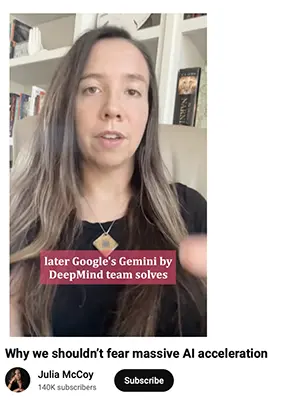
Why we shouldn’t fear massive AI acceleration
✅ Executive Summary
In this July 22, 2025 video, Julia McCoy reflects on two AI breakthroughs: OpenAI’s unreleased model and Google’s DeepMind Gemini both solving International Mathematical Olympiad problems within days of each other. She frames this moment as a signal of the exponential acceleration of AI intelligence—particularly in traditionally human-dominated domains like mathematics. Rather than express fear, McCoy calls for a mindset shift away from industrial-era limitations, encouraging society to embrace AI as a tool for human liberation from repetitive machine work. She also hints at a new economic paradigm driven by AGI, decentralized systems, and equitable wealth distribution.
💼 Relevance for Business
McCoy’s video highlights a pivotal turning point: AI is now not just competing with, but surpassing, human performance in elite tasks—posing both opportunities and disruptions for business strategy, workforce models, and economic structures.
📌 Calls to Action for SMB Executives
- ✅ Monitor progress in AI reasoning and mathematical capability—these advances will ripple into finance, logistics, and strategic modeling.
- ✅ Begin discussions with leadership and HR about redefining roles and upskilling employees as AI becomes more agentic.
- ✅ Watch developments in decentralized AI and blockchain-powered economic models; these may reshape how value is created and distributed.
- ✅ Embrace AI tools as productivity partners—delegate machine work to machines, and reinvest human labor in creative and strategic tasks.
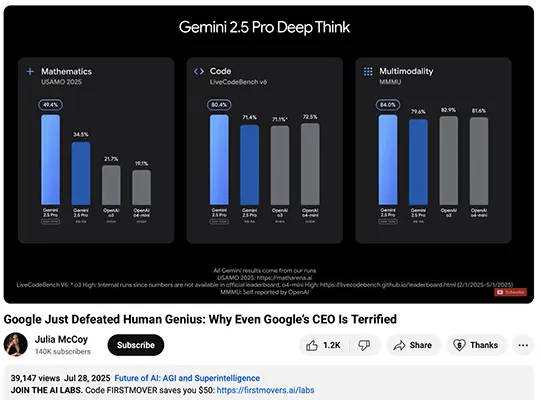
Google Just Defeated Human Genius: Why Even Google’s CEO is Terrified
✅ Executive Summary
In this July 29, 2025 video, Julia McCoy explains how Google’s Gemini model with DeepThink achieved a gold medal at the International Mathematical Olympiad, a feat previously thought impossible for AI for at least another decade. McCoy argues this isn’t just a milestone—it’s evidence that Google’s AI now demonstrates superhuman reasoning, applying general-purpose language models to elite mathematical challenges. The video outlines how this changes the future of Google’s products, with implications for search, advertising, quantum computing, and more. Even Google’s leadership is reportedly shaken, as the company enters an accelerated feedback loop where AI begins improving its own architecture.
💼 Relevance for Business
This development underscores the urgent need for SMBs to track not only AI adoption but AI’s growing capacity for autonomous reasoning. The same models that outperform PhDs in math may soon redefine automation, search relevance, pricing, diagnostics, logistics, and decision-making.
📌 Calls to Action for SMB Executives
- ✅ Monitor advancements in AI reasoning and multi-step logic—these breakthroughs will soon power enterprise search, finance, and diagnostics.
- ✅ Explore partnerships or pilot programs with AI vendors offering advanced models to stay ahead of competitors.
- ✅ Develop internal playbooks for adapting workflows to agentic and reasoning-based AI tools.
- ✅ Begin reskilling or retraining staff around prompt engineering, AI oversight, and strategic application of reasoning models.

“AI Crushed the World’s Smartest Humans”
✅ Executive Summary
In this video, Julia McCoy explains how an internal experimental model at OpenAI—a general-purpose reasoning AI—unexpectedly earned a gold medal at the International Mathematical Olympiad (IMO), marking a stunning leap in AI’s problem-solving ability. Unlike specialized math AIs, this model achieved victory using general reasoning, catalyzing a dramatic shift in expert expectations around AGI timelines. McCoy frames this as an “intelligence explosion,” where AI improves itself by mastering foundational disciplines like math, science, engineering, and even AI research. The video closes with a passionate reminder that AI is a tool for human liberation, not replacement, encouraging viewers to embrace it for productivity, innovation, and personal freedom.
💼 Relevance for Business
OpenAI’s math triumph signals a shift from task-based AI to reasoning-based agents that can transform R&D, financial modeling, and operational strategy. For SMB leaders, it is essential to understand that these models are rapidly moving from experimental breakthroughs to commercially usable tools—and that adopting them early will be key to competitive survival.
📌 Calls to Action for SMB Executives
- ✅ Explore AI tools that go beyond automation into logical reasoning, prediction, and design.
- ✅ Begin internal pilot programs that pair staff with AI co-pilots for modeling, planning, or analysis.
- ✅ Monitor AGI timelines and breakthroughs in “general-purpose models” as they will affect knowledge work and strategic planning.
- ✅ Encourage leadership teams to shift from fear to fluency—invest in training that emphasizes ethical, empowered AI usage.
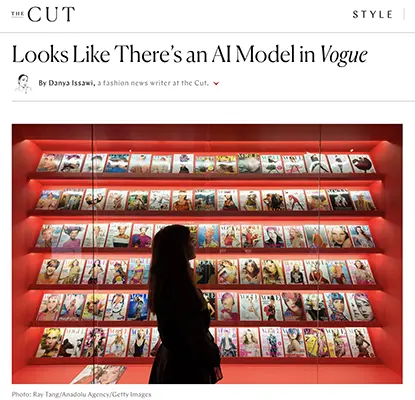
“Looks Like There’s an AI Model in ‘Vogue’” by Emma Hinchliffe, published in Fortune on July 22, 2025:
✅ Executive Summary
Vogue’s August 2025 issue features an AI-generated model named “Aitana” created by Spanish startup The Clueless, sparking both excitement and controversy in the fashion world. Designed using tools like Midjourney and Photoshop, Aitana now commands major brand deals and millions of Instagram followers—despite not being a real person. Critics raise concerns over transparency, body image standards, and the displacement of real models, while Vogue defends the experiment as a reflection of AI’s growing role in fashion and media. This moment marks a broader trend of synthetic influencers gaining traction in commercial campaigns, signaling the arrival of AI-driven personalities in consumer markets.
Relevance for Business:
For SMBs, especially in retail, fashion, and marketing, AI-generated personas present both opportunities for cost-effective branding and risks related to authenticity and ethics.
Calls to Action for SMB Executives:
- ✅ Explore AI-generated models or influencers as scalable branding tools, especially for digital-first campaigns.
- ✅ Establish clear disclosure practices to maintain consumer trust when using synthetic media.
- ✅ Monitor evolving industry norms around AI in advertising to avoid reputational backlash.
- ✅ Evaluate where AI-generated content could supplement—not replace—human storytelling.

🔹 Executive Summary
“The Vogue AI Model Backlash Isn’t Dying Down Anytime Soon”
By Eve Upton-Clark, Fast Company, July 28, 2025
In Vogue’s August issue, a Guess advertisement featuring an AI-generated model sparked major backlash, with critics calling it “cheap,” “lazy,” and “the downfall of Vogue.” While the magazine claims the model’s inclusion was purely advertising, not editorial, many readers—and longtime subscribers—aren’t buying it. The campaign, created by Seraphinne Vallora at the request of Guess cofounder Paul Marciano, exemplifies the growing tension between AI-enhanced content and consumer expectations of authenticity. Online responses point to deeper anxieties about unrealistic beauty standards and the erosion of creative credibility in fashion.
Relevance for Business:
This controversy highlights the reputational risk companies face when deploying AI-generated visuals without transparent context or audience alignment. Brands must carefully assess where and how AI fits within consumer-facing narratives to avoid backlash and brand damage.
Calls to Action:
- 📢 Evaluate AI use in advertising for alignment with brand values and public sentiment.
- 🧠 Monitor customer response channels to detect early signs of reputational fallout.
- 🧍♀️Prioritize inclusion and authenticity if deploying synthetic media, especially in identity-centric industries like fashion and beauty.
- 📝 Clearly label AI-generated content to foster trust and transparency.
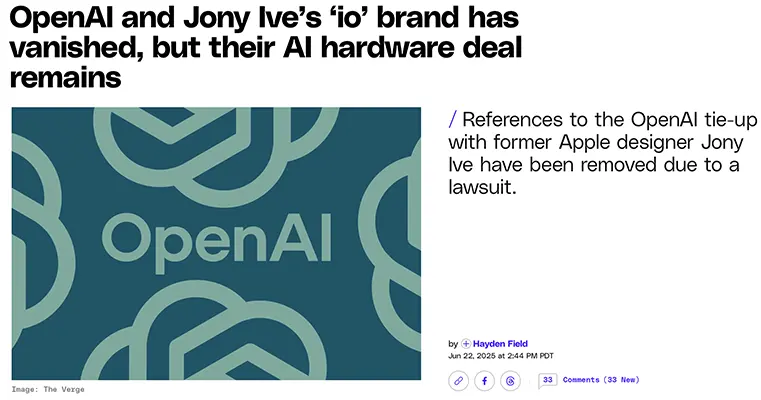
“OpenAI and Jony Ive’s ‘IO’ brand has vanished, but their AI hardware deal remains” by Hayden Field from The Verge (June 22, 2025).
Executive Summary:
OpenAI has quietly removed all public references to its “io” AI hardware collaboration with renowned Apple designer Jony Ive due to a trademark dispute with hearing device company iyO. Despite this branding setback, OpenAI confirmed to The Verge that the $6.5 billion partnership with Ive’s hardware team remains intact. The scrubbed blog post and video originally promised a family of AI products developed closely with OpenAI’s research and engineering divisions. This disruption highlights the legal and reputational complexities that accompany high-profile AI innovation projects.
Relevance for Business:
SMB executives should be aware that even the most ambitious AI ventures are susceptible to branding, legal, and regulatory risks—issues that can derail public perception or delay product rollouts.
Calls to Action for SMB Executives:
- ✅ Monitor the legal landscape surrounding trademarks and AI branding before launching AI products or spin-offs.
- ✅ Take cues from OpenAI’s response and plan for contingency communication strategies in the event of legal disruption.
- ✅ Keep an eye on the OpenAI–Jony Ive hardware development—its design direction could inform future user-centric AI interfaces.
- ✅ Use this example to audit your own partnerships for potential IP vulnerabilities before they scale.
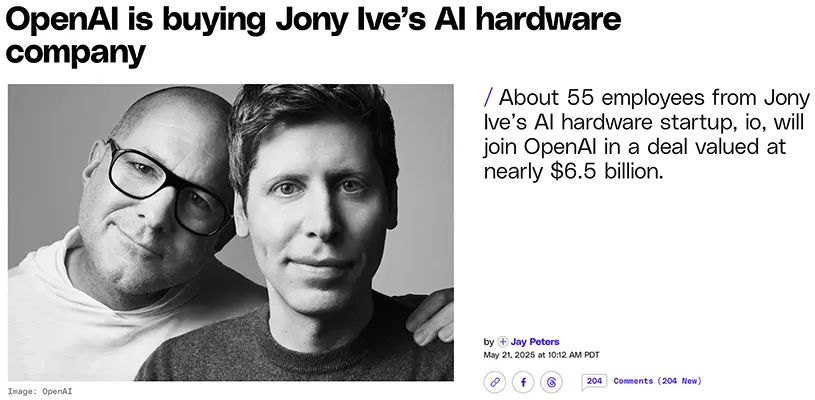
“OpenAI is buying Jony Ive’s AI hardware company” by Jay Peters, published in The Verge on May 21, 2025.
✅ Executive Summary
OpenAI has acquired Jony Ive’s AI hardware startup, io, for nearly $6.5 billion, bringing 55 engineers and experts from the design legend’s team into its fold. While Ive himself won’t join OpenAI, his design firm LoveFrom will lead design across OpenAI’s entire product line—hardware and software. The first product, set to launch in 2026, is reportedly a pocket-sized, screen-free, context-aware device that both Sam Altman and Ive believe could define a new category of human-centric AI. The acquisition underscores OpenAI’s ambition to create seamless hardware interfaces that embody its AI models in physical form.
Relevance for Business:
This move signals a critical shift in AI adoption—from digital tools to integrated physical experiences. SMBs should prepare for a wave of AI-native devices that will reshape both internal operations and customer interactions.
Calls to Action for SMB Executives:
- ✅ Track developments in AI hardware as the market moves beyond screen-based applications.
- ✅ Consider how hands-free, intelligent devices could augment customer service, logistics, or remote operations.
- ✅ Study OpenAI’s design-first strategy as a model for merging AI functionality with intuitive user experience.
- ✅ Prepare for interface shifts that go beyond smartphones—adapt communication channels and workflows accordingly.
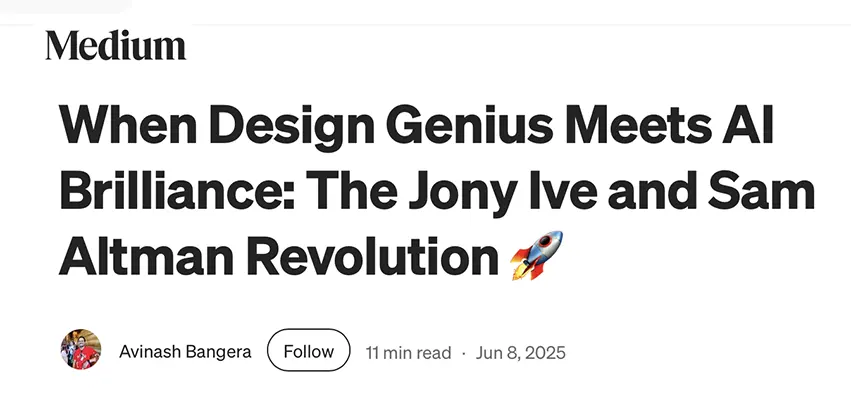
“When Design Genius Meets AI Brilliance: The Jony Ive and Sam Altman Revolution” by Avinash Bangera, published in Medium in June 2025.
✅ Executive Summary
Avinash Bangera explores the high-stakes collaboration between Jony Ive and Sam Altman as they develop a new AI-native hardware product that aims to revolutionize human-machine interaction. Drawing comparisons to the launch of the iPhone, the project is positioned as a convergence of Apple-caliber design and cutting-edge AI—delivering a pocket-sized, context-aware device that’s screen-free and human-centric. Ive brings his obsessive focus on form and experience, while Altman provides access to OpenAI’s advanced models and infrastructure. The initiative could mark a turning point in computing, transitioning from app-based smartphones to ambient, intelligent companions.
Relevance for Business:
For SMBs, this signals a future shift in consumer behavior and tech platforms—where interacting with AI may no longer require screens, apps, or even keyboards.
Calls to Action for SMB Executives:
- ✅ Begin scenario planning for screenless AI interfaces and how they could impact customer engagement, retail, and service channels.
- ✅ Follow product developments from the Altman–Ive collaboration to stay ahead of UI/UX design trends shaped by AI.
- ✅ Consider how your current digital strategy may need to evolve if conversational, ambient devices become mainstream.
- ✅ Reevaluate hardware assumptions—AI-native devices may alter device dependencies for both employees and customers.

July 15, 2025 video by Julia McCoy’s channel (voiced by her AI clone): The $14 Billion AI Acquisition That Changes Everything.
✅ Executive Summary
In her July 15, 2025 video, Julia McCoy analyzes Meta’s $14 billion investment in Scale AI as a strategic pivot—not to acquire a data-labeling company, but to secure AI talent and IP while bypassing regulatory scrutiny. This “license & release” deal structure, now favored by Big Tech, allows firms to gain access to teams and tech without triggering traditional acquisition reviews. With synthetic data threatening Scale AI’s business model, Meta’s move is less about infrastructure and more about rebuilding its credibility after the underwhelming LLaMA 4 release. The video outlines how these stealth acquisition strategies are redefining the AI landscape—and why SMBs must understand them to navigate future partnerships or threats.
Relevance for Business:
SMBs operating near AI, data, or SaaS markets must understand these acquisition models as they signal changing competitive dynamics, new funding routes, and evolving regulatory blind spots.
Calls to Action for SMB Executives:
- ✅ Study “license and release” deal structures to understand how Big Tech is acquiring talent and tech without formal takeovers.
- ✅ Reassess your startup’s exit or partnership strategy—traditional acquisitions may be replaced by hybrid investment plays.
- ✅ Monitor the competitive ripple effects of Big Tech’s stealth consolidation of AI talent and pipelines.
- ✅ Prepare for increased M&A opacity—develop internal literacy on how acquisition strategies may affect supplier or customer ecosystems.
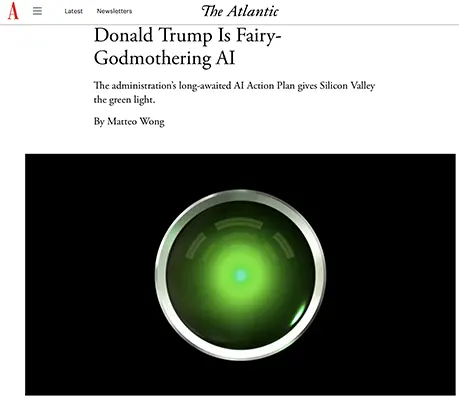
“Donald Trump’s Gift to AI Companies” by Matteo Wong, published in The Atlantic on July 23, 2025.
✅ Executive Summary
President Trump’s newly unveiled AI Action Plan aggressively accelerates U.S. AI development by slashing regulations, expanding infrastructure, and openly aligning with the private sector’s priorities. The 23-page plan, shaped by recommendations from firms like OpenAI, Anthropic, and Microsoft, promises streamlined permitting, reduced oversight, and an “innovation-first” strategy—especially in military, healthcare, and scientific domains. It dismisses environmental and IP concerns, downplays diversity and misinformation frameworks, and positions China as a looming threat to justify rapid expansion. As a result, Silicon Valley has effectively received a green light to scale AI ambitions with fewer legal and regulatory constraints.
Relevance for Business:
SMBs must understand that this federal push for unchecked AI growth will influence market dynamics, shift funding priorities, and create both opportunities and competitive pressures—especially in sectors tied to infrastructure, logistics, and federal contracts.
Calls to Action for SMB Executives:
- ✅ Track federal funding and procurement programs for AI and infrastructure—especially those aligned with national security or healthcare.
- ✅ Stay alert to changing compliance landscapes in data privacy, environmental standards, and IP laws.
- ✅ Evaluate whether “sandbox” testing zones and deregulated environments offer pilot opportunities for new AI products.
- ✅ Prepare for rising competition from large AI-backed firms operating with expanded federal support and reduced regulation.
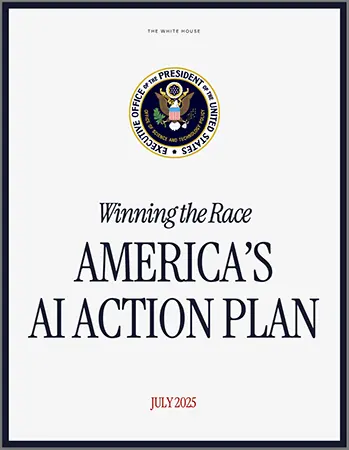
“America’s AI Action Plan” (July 2025) published by the White House under President Donald J. Trump.
Executive Summary
The America’s AI Action Plan (July 2025) outlines a comprehensive, three-pillar national strategy to secure U.S. dominance in artificial intelligence through aggressive innovation, infrastructure development, and international diplomacy. Framed as a race for technological supremacy, the plan emphasizes deregulation, open-weight models, workforce upskilling, and defense modernization, while rejecting what it characterizes as “radical climate dogma” and “ideological bias” in AI systems. The plan seeks to rapidly expand AI adoption in industry and government by dismantling regulatory barriers, fast-tracking AI infrastructure (like data centers and energy grids), and embedding AI across national defense, manufacturing, healthcare, and education sectors.
The document sharply pivots from prior administrations, reversing several Biden-era AI regulations and calling for policies that align AI development with American values such as free speech and national security. It recommends creating a robust AI workforce pipeline, incentivizing scientific datasets, and expanding global influence through strategic export and governance efforts. The plan calls for a business-friendly AI ecosystem led by the private sector, supported by secure infrastructure, and protected from adversarial threats, especially from China.
Relevance for Business
This Action Plan will directly shape the regulatory, economic, and infrastructure landscape in which U.S. businesses operate with AI. For SMBs, the emphasis on open-source models, deregulation, tax-incentivized upskilling, and AI workforce development opens up new opportunities for innovation, talent acquisition, and market expansion. However, companies may also face scrutiny on AI bias, IP protection, and compliance with national security standards.
Calls to Action for SMB Executives & Managers
- Evaluate current use of AI tools: Assess how your organization could benefit from new regulatory sandboxes, open-weight models, and workforce training incentives.
- Invest in upskilling employees: Take advantage of emerging tax benefits and federal programs that support AI literacy and retraining for existing teams.
- Monitor procurement and funding channels: Stay informed about AI-related grants, infrastructure initiatives, and compliance requirements tied to federal funding eligibility.
- Plan for AI integration in operations: Consider how automation, data infrastructure, and public-private partnerships can enhance your company’s productivity.
- Engage with trusted AI vendors: Ensure AI tools align with “American values” such as free speech, transparency, and objective outputs as emphasized in federal standards.
: August 5, 2025 Updates https://www.whitehouse.gov/articles/2025/07/white-house-unveils-americas-ai-action-plan/: August 5, 2025 Updates
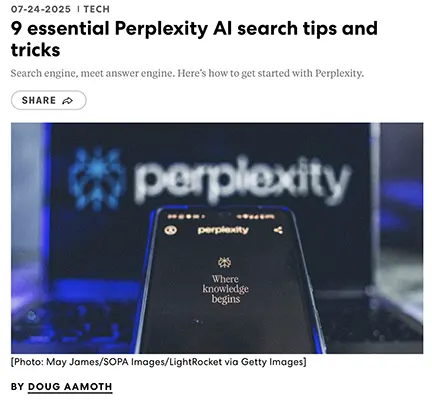
“9 Essential Perplexity AI Search Tips and Tricks” by Doug Aamoth, published in Fast Company on July 24, 2025:
Executive Summary:
Perplexity AI positions itself as a real-time “answer engine” rather than a traditional generative chatbot, offering concise, sourced responses ideal for research and decision-making. Doug Aamoth outlines how users can leverage Perplexity’s advanced features—such as natural language querying, source filtering, follow-up threading, and daily Pro Searches—to improve productivity and accuracy. Unlike ChatGPT or Gemini, Perplexity emphasizes factual retrieval and citation transparency, making it well-suited for business applications that demand traceable insights. The platform’s conversational design and customizable source targeting make it an increasingly valuable tool for professionals navigating the fast-paced information landscape.
Relevance for Business:
Perplexity AI enables business leaders and teams to extract reliable, up-to-date information rapidly—crucial for strategic planning, competitive analysis, and operational decision-making in AI-driven markets.
Calls to Action for SMB Executives:
- ✅ Incorporate Perplexity into market research and competitor tracking workflows to improve speed and confidence in decision-making.
- ✅ Train staff to use Pro Search features and citation tools to ensure accurate, sourced insights for reports and strategic memos.
- ✅ Experiment with source filters (e.g., Finance, Academic, Social) to tailor insights to different departments and functions.
- ✅ Encourage use in client presentations and planning documents to showcase evidence-backed insights and AI literacy.
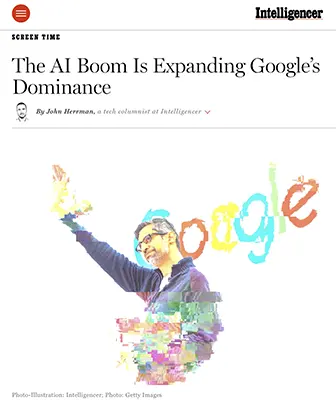
“The AI Boom Is Expanding Google’s Dominance”by John Herrman, published in Intelligencer on July 25, 2025:
✅ Executive Summary
John Herrman explores how Google is capitalizing on the AI boom by transforming its core search product into a proprietary AI platform that deprioritizes web links in favor of generated answers. With new features like “AI Overviews” and “AI Mode,” Google is embedding chatbots across its ecosystem, reaping advertising benefits while drastically reducing outbound web traffic. This shift, while boosting Google’s bottom line, is causing concern among publishers, content creators, and infrastructure providers who see their visibility and monetization threatened. Despite regulatory scrutiny and competition from OpenAI, Google’s entrenched infrastructure gives it a dominant edge in the AI era.
Relevance for Business:
As Google rewires search around AI, companies reliant on search visibility must re-strategize digital outreach, SEO, and content monetization—especially in light of shrinking referral traffic.
Calls to Action for SMB Executives:
- ✅ Audit your web traffic sources and monitor declines in Google-driven visits due to AI summaries.
- ✅ Explore alternative visibility channels—such as newsletters, LinkedIn content, or Perplexity AI search optimization.
- ✅ Reassess SEO strategies to adapt to Google’s new AI-structured results and evolving user behavior.
- ✅ Prepare contingency plans for reduced web discoverability and experiment with AI-enhanced content experiences.
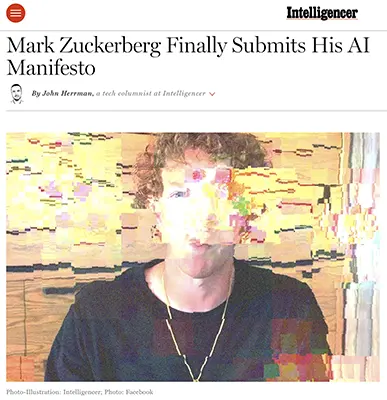
Executive Summary: Mark Zuckerberg’s AI Manifesto — A Vision for Personal Superintelligence
In “Mark Zuckerberg Finally Submits His AI Manifesto,” tech columnist John Herrman (Intelligencer, July 31, 2025) dissects Zuckerberg’s long-awaited entry into the AI manifesto genre with a critical lens. Titled “Personal Superintelligence,” Zuckerberg’s memo mimics the tone and ambition of peers like Sam Altman and Dario Amodei but attempts to set Meta apart by promoting an egalitarian vision of AI—one that enhances individual creativity, relationships, and personal fulfillment rather than replacing labor wholesale. Herrman notes the document’s rhetorical gymnastics: grand in its claims, vague in its definitions, and strategically styled to assert Zuckerberg’s credibility within elite AI circles. However, skepticism surrounds Meta’s supposed divergence from competitors, especially given its history of mimicking AI trends and a leadership image at odds with its empowering message.
Relevance for Business:
For SMB executives, Zuckerberg’s manifesto signals a broader shift in big tech’s AI messaging—from backend automation to front-facing empowerment tools. It reflects where enterprise tech may be heading: context-aware AI that’s personalized, wearable, and aimed at augmenting, not replacing, human tasks. The move also hints at new product categories and partnerships in personalized AI devices—potentially reshaping consumer behavior and employee productivity alike.
Calls to Action for SMB Executives & Managers:
- Evaluate “Personal AI” Trends: Track the emergence of personalized AI assistants, as this could impact both internal operations and customer service models.
- Prepare for Augmented Workflows: Invest in training and tools that enable your team to collaborate with context-aware AI systems rather than fear automation.
- Watch Meta’s Next Moves: Meta’s shift may bring new APIs, SDKs, or wearables—evaluate early if integration makes sense for your business ecosystem.
- Scrutinize the Messaging: Be aware of how tech giants frame AI as “empowering”—dig deeper into actual functionality, privacy implications, and ROI.
- Reassess Competitive Positioning: If Meta’s bet on “personal superintelligence” gains traction, SMBs in SaaS, productivity, or customer engagement spaces should reassess their value propositions in light of new AI UX expectations.
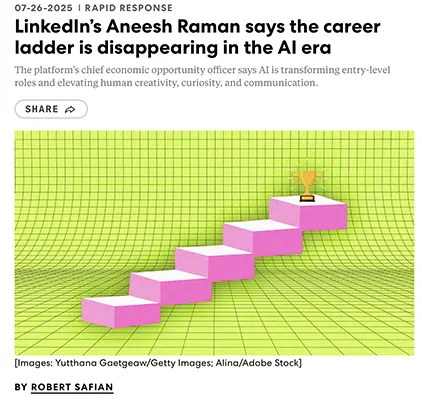
“LinkedIn’s Aneesh Raman says the career ladder is disappearing in the AI era” by Robert Safian, published on Fast Company (July 26, 2025):
Executive Summary:
LinkedIn’s Chief Economic Opportunity Officer, Aneesh Raman, argues that AI is reshaping traditional career trajectories, replacing the linear “career ladder” with a more dynamic “climbing wall” of diverse, nonlinear opportunities. As AI takes over repetitive entry-level tasks, human-centric skills like creativity, communication, and adaptability are becoming the most valued traits in the evolving job market. Raman emphasizes that while job titles and tasks may change, the human role in innovation and complex problem-solving will become even more essential. The challenge and opportunity for businesses lie in preparing for a future where workforce development focuses less on hierarchy and more on flexibility, soft skills, and project-based collaboration.
Relevance for Business:
This insight calls on business leaders to rethink talent acquisition, training, and organizational design in an AI-augmented economy. The emerging “innovation economy” will reward companies that value and develop human capabilities alongside AI systems.
Calls to Action for SMB Executives:
- ✅ Reassess hiring criteria to prioritize communication, strategic thinking, and adaptability over technical credentials alone.
- ✅ Invest in workforce upskilling to help current employees transition from task-based roles to more creative, collaborative functions.
- ✅ Experiment with flatter organizational models, such as project-based teams, to foster agility and innovation.
- ✅ Prepare for new roles and job titles that emerge from AI integration—be proactive rather than reactive.
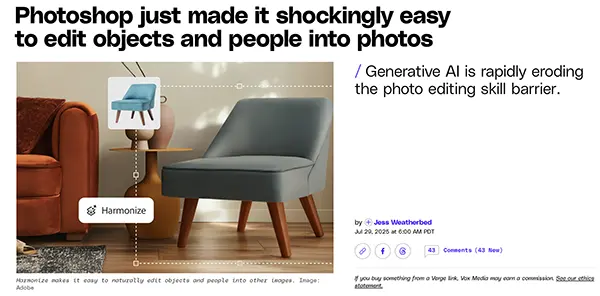
“Photoshop just made it shockingly easy to add objects into photos” by Jess Weatherbed, published in The Verge on July 29, 2025.
✅ Executive Summary
Adobe has released a suite of powerful generative AI features for Photoshop, including the new “Harmonize” tool, which automatically blends added objects into photos with realistic lighting and shadows. Other updates include high-quality AI upscaling, enhanced object removal, and smarter auto-compositing—all designed to lower the barrier to professional-grade image editing. While Adobe emphasizes content authenticity through digital “Content Credentials,” critics worry about the potential misuse of these tools for misinformation or deepfakes. These advances mark a major shift in creative workflows, enabling even non-experts to produce convincing, professional visuals at scale.
Relevance for Business:
SMBs in marketing, design, e-commerce, and content creation now have unprecedented access to advanced photo editing, which can significantly reduce creative costs and increase content velocity.
Calls to Action for SMB Executives:
- ✅ Train marketing and design teams to leverage these new AI tools for faster, professional-grade content creation.
- ✅ Evaluate where AI-generated visuals can streamline ad campaigns, product catalogs, or social media content.
- ✅ Establish internal standards for content disclosure and authenticity to maintain brand trust.
- ✅ Stay alert to the legal and ethical implications of generative image use, particularly in advertising and media.
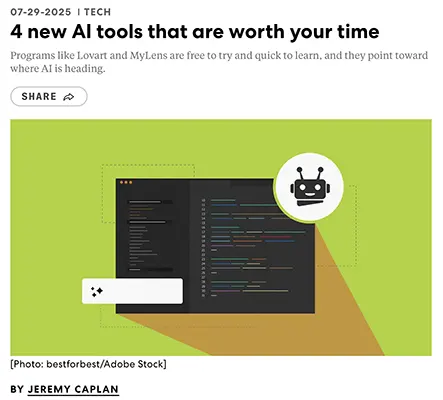
🔹 Executive Summary
“4 New AI Tools That Are Worth Your Time”
By Jeremy Caplan, Fast Company, July 29, 2025
Jeremy Caplan spotlights four innovative AI tools—Lovart, Google’s Little Language Lessons, Gemini Scheduled Actions, and MyLens—that are practical, intuitive, and free or low-cost. Lovart simplifies branding with a conversational AI designer, while MyLens turns raw text or links into infographics. Google’s Little Language Lessons enhances multilingual skills through micro-learning, and Gemini’s Scheduled Actions offers personalized daily AI automation. Each tool reflects where AI is heading: toward more accessible, creative, and personalized productivity solutions.
Relevance for Business:
These tools offer small and mid-sized businesses affordable, scalable ways to streamline marketing, automate updates, and enhance communication across teams and customers.
Calls to Action:
- 🎨 Experiment with Lovart to develop low-cost branding assets and campaign visuals.
- 🌍 Encourage staff to use Google’s Little Language Lessons to improve global communication.
- 🧠 Set up Gemini or ChatGPT Tasks to deliver daily briefings and AI-generated productivity tips.
- 📊 Use MyLens to quickly turn presentations, reports, or YouTube content into shareable visuals.
↑ Back to Top
